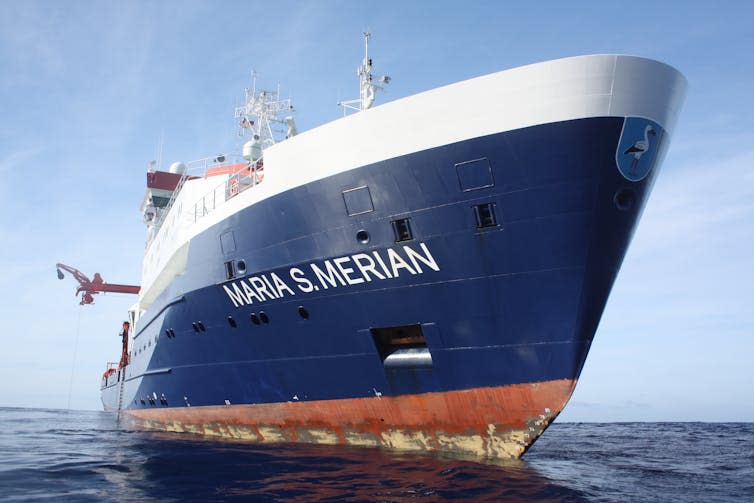Underwater avalanches are powerful natural events that occur constantly beneath the ocean’s surface. They are impossible to see and extremely difficult to measure, meaning we know little about how they work.
Yet these phenomena pose a threat to our global communications networks. The proliferation of the Internet requires an ever-expanding network of fiber-optic cables on the seabed, which carry virtually all of the world’s Internet traffic.
My new research on an ancient underwater avalanche challenges our knowledge of how underwater avalanches develop and could change the way geologists assess their risks.
It is estimated that there are now more than 550 active seabed cables worldwide, with a total length of 1.4 million km. That is enough to wrap around the circumference of the Earth 35 times.
When an underwater avalanche ruptures seabed cables, the consequences can be widespread and costly. The 2006 Pingtung earthquake in Taiwan caused underwater avalanches that severed many seabed cables connecting Southeast Asia to the rest of the world. China’s largest internet service provider reported a loss of 90% of traffic to the US at the height of the event, and Taiwan experienced a loss of 74-100% of internet traffic to neighboring islands.
This damaged global markets by drastically reducing the amount of financial transactions that could take place. It took 39 days to get the network back up to full capacity, costing millions of US dollars in ship time. The underwater avalanche that snapped these cables was moving rapidly, at a top speed of 45 miles per hour. But it was relatively small compared to the giant underwater avalanches I have investigated in the Atlantic Ocean.
The good news is that there are so many cables on the seabed that it is highly unlikely that an underwater avalanche could take down the internet worldwide. The Pingtung earthquake is an example of how even when the main routes are closed, traffic can still travel via an alternative route.
In a new research paper, my colleagues and I map the devastation caused by a giant underwater avalanche 60,000 years ago, from its source area off the coast of Morocco.
It traveled 400 km through the world’s largest underwater canyon and another 1,600 km across the Atlantic Ocean floor. [(no link yet as it will be published on wednesday evening DOI: 10.1126/sciadv.adp2584)]. It is the second largest underwater avalanche ever documented.
We mapped the avalanche using a combination of detailed topographic maps of the seafloor and hundreds of sediment cores, which penetrated the avalanche deposits over a huge area. In each core, we analyzed the deposits for fossils, which allowed us to determine that the event occurred 60,000 years ago. It also meant that we could correlate the individual avalanche layers over thousands of kilometers.

The avalanche contained enough sediment to fill 140,000 Wembley Stadium (162 km³). It was the height of a skyscraper (over 200 metres), travelling at at least 54 km per hour and tore a trench 30 metres deep and 15 km wide across 400 km (the distance from London to Liverpool) that destroyed everything in its path. The avalanche then spread across an area the size of Germany, burying it in about a metre of sand and mud.
However, we show that the avalanche actually started as a small landslide, which subsequently grew more than 100 times in size along its path. This extreme growth in size is much larger than for land avalanches, which typically grow four to eight times in size and are small in comparison. This challenges the view of scientists that large avalanches start as a large slope collapse.
Instead, we now know that underwater avalanches can start small and develop over the course of their path into catastrophic events of extraordinary force. These insights could therefore change how we assess the geological hazard of these phenomena, and could lead us to focus more on the avalanche path rather than the original landslide zone.
How often these events occur depends on where you are. Seafloor canyons that begin relatively close to river mouths with high rainfall may experience several small avalanches per year. Other systems far from river outlets, such as the Agadir Canyon, off the coast of northwestern Morocco, only have one giant avalanche every 10,000 years.
There are several potential triggers for underwater avalanches, including earthquakes, tides, typhoons, river floods, and even volcanic eruptions. Climate change will cause some of these triggers to become more frequent and intense.
However, triggers do not guarantee that an avalanche will occur, nor do they have any correlation to the magnitude of the event. For example, in 1755 a large earthquake struck off the coast of Portugal, destroying much of Lisbon and killing tens of thousands of people. However, it only caused a small underwater avalanche. By comparison, in 1929 a large earthquake off the coast of Newfoundland, Canada, caused the largest underwater avalanche ever documented.
My colleagues and I used detailed seafloor surveys and sediment cores to reconstruct the properties of this event, which traveled at 42 miles per hour, carrying a concentrated mix of boulders, sand, and mud, and snapped 11 seafloor cables as it traveled downhill. The avalanche was so large that it triggered a tsunami, killing 28 people along the local coastline. This remains the first and only giant underwater avalanche to be directly measured by cable breaks.
Our understanding of underwater avalanches is still in its infancy, but research continues to provide new insights into where they happen, how they work, and how powerful and destructive they can be. These fascinating events are a reminder of the many wonders still hidden in the deep sea.
This article is republished from The Conversation under a Creative Commons license. Read the original article.
Christopher Stevenson is not an employee of, an advisor to, an owner of stock in, or a recipient of funding from any company or organization that would benefit from this article, and has disclosed no relevant affiliations beyond his academic appointment.